iPhone 5 vs iPhone 4S vs iPad 3 vs Android: Benchmark shootout
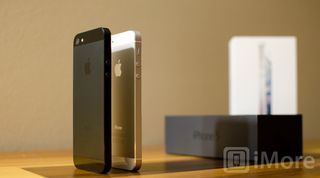
For some, simply knowing that the new iPhone 5 is twice as fast as the last iPhone is enough. But some of us want numbers. We want to know how much faster. Sure, Apple typically brings experience to a spec fight, but it's the specs that drive the experience. It's the engine in the meticulously appointed car. It's the stats behind the championship team. It's the science behind the art.
So with that in mind we ran the iPhone 5 through a whole battery of benchmarks, and to give it some context we put it up head to head, device to device against the iPhone 4S, iPad 3, and added in scores for the Samsung Galaxy S3 and a sampling of other, competing phones like the HTC One X, the Nokia Lumia 900, and the BlackBerry 10 Developer Alpha.
Benchmarking environment
Pulling a device out of the box and running benchmarks is fine, but it doesn't necessarily give real world results. Odds are the first thing you'll do is load up your iPhone 5 with the usual suspects - apps, games, contacts, calendars, reminders, music, video, etc..
So for this test I restored an iCloud backup to my iPhone 5 that's already on my iPad 3 and iPhone 4S so they're both loaded with tons of the same data. It seems a little more practical than comparing it straight out of the box. All devices were also running the iOS 6 public release candidate.
As a preface, the only thing I did before performing any of these benchmarks was close out all apps from the multitasking tray. At the time either the benchmarking app was the only thing running or Safari in order to obtain the benchmarks.
The Android, Windows Phone, and Blackberry 10 results were not performed by us. They are averages from each respective benchmarking site or verified data from on of our cross-platform sites - Android Central, wpcentral, or Crackberry.
Geekbench

The iPhone 4S uses an Apple A5 system-on-a-chip (SoC), which combines a dual-core ARM Cortex A9 processor clocked at 800MHz with a dual-core PowerVR SGX543MP2 graphics chip and 512MB of RAM. The iPad 3 ups the game with an A5X SoC with the same CPU clocked at 1GHz, a quad-core PowerVR SGX543MP4 graphics chip, and 1GB of RAM.
Master your iPhone in minutes
iMore offers spot-on advice and guidance from our team of experts, with decades of Apple device experience to lean on. Learn more with iMore!
For the iPhone 5, instead of licensing the next-generation ARM design, the A15, Apple custom-built their own Apple A6 SoC based on the ARM instruction set. It's a dual-core ARMv7 processor reportedly clocked around 1.25GHz along with a triple-core SGX 543MP3 and 1GHz of RAM.
To put all this into perspective, we performed a hard reboot on each device, killed all running apps, and then ran tests using Geekbench 2 for iOS. Now Geekbench isn't a great comparison tool -- writing something that tests CocoaTouch apps on iOS, JVM apps on Google, and other platforms in a consistent way is nearly impossible. How fast Infinity Blade 2 launches, or the App Store loads up its interface, or the camera takes to shoot a picture is a better indicator of day-to-day performance. However, it's the tool we have and the number everyone always asks for, so we're running it.
- $0.99 - Download now
Geekbench looks at all kinds of information across the entire system, including integer, floating point, memory, and stream performance.Higher numbers are better.
iPhone 5

The iPhone 5 scored between 1500 and 1650 each time we ran the rest. The average of 5 consecutive tests was 1615.
iPhone 4S

After 5 consecutive tests, the average was around 635. That puts the iPhone 4S far lower on the Geekbench scale than the iPhone 5.
iPad 3
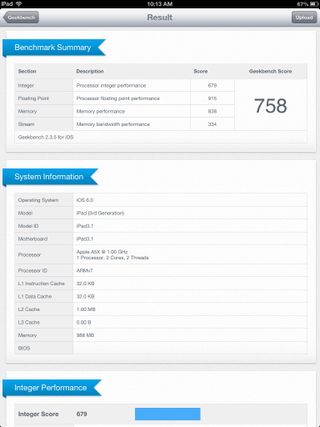
Our average result on Geekbench for the iPad 3 was around 750 after 5 consecutive tests.
The A5X processor obviously performs significantly better than the iPhone 4S' standard A5 but when it comes to the A6, the iPhone 5 wins each and every time.
Other devices
If you're wondering how the iPhone 5 stacks up against other devices that have been benchmarked using Geekbench, here are some reference numbers for popular Android devices.
- Samsung Galaxy S III LTE - 1582
- Samsung Galaxy S III (North America) - 1429
- HTC One X - 1530
And just for fun:
- MacBook Air (11-inch Mid 2012) - 6866
- Power Mac G5 (June 2004) - 1580
Sunspider

Sunspider measures Javascript performance in the web browser. It includes real-world situations like encryption and text manipulation and measures response time in milliseconds for each test. After running each test 5 times, Sunspider gives an average number of time (in milliseconds). Like Geekbench, Sunspider can be a mixed bag. Some browsers include hacks designed just to do better on Sunspider. How fast iMore or the New York Times or Facebook loads on your phone is much better indicator. But again, it's a number people want to hear, so hear it it.
Lower numbers are better.
iPhone 5

I ran Sunspider on my iPhone 5 three times and each time I ended up around the 915 to 920 ms mark. While running the test I had no other app open on the device other than the native Safari browser.
iPhone 4S
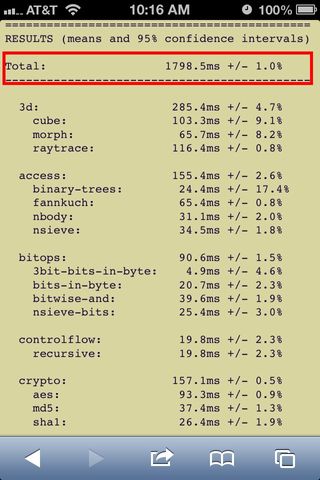
Just like the iPhone 5, we ran the rest three times on the iPhone 4S will nothing open but Safari and after another hard reboot. All three tests resulted in a time of around 1800 ms.
When it comes to rendering Javascript, it's quite obvious the iPhone 5 can process it almost twice as fast as the iPhone 4S can.
iPad 3
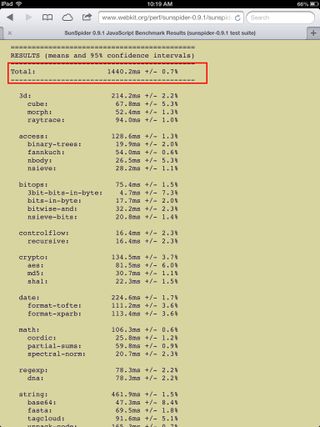
The iPad 3 faired better than the iPhone 4S with an average score of around 1450 ms. It isn't a huge difference when it comes to rendering Javascript and probably not one that many users would even notice.
When compared to the iPhone 5, however, the A5X chipset can't hold its own against the A6. It's obvious the iPhone 5 is an all around faster device when it comes to system and rendering benchmarks.
Other devices
Here's some average benchmarks for other popular devices on the market and how they score with Sunspider on average. Remember, the lower the number the better.
- Samsung Galaxy S III LTE - 1442
- HTC One X - 1650
- Nokia Lumia 900 - 6800
HTML5Test.com
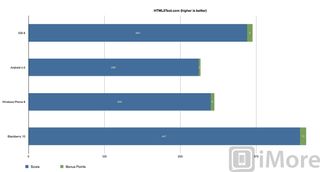
HTML5Test.com measures how well a browser supports and renders HTML5 content. While it isn't as in-depth as tests like Sunspider and Geekbench, it's still worth taking a look at if only to see how much companies like Apple, Google, Microsoft and RIM prioritize HTML5 compliance.
iPhone 4, iPhone 4S, & iPad 3

Considering the iPhone 5, iPhone 4S, and iPad 3 all run the same version of iOS and support the same native Safari browser within it, all three devices scored a total of 360 points plus 9 bonus points. HTML5Test.com uses a 500 point scale.
Other devices

Here's how a couple other devices stacked up when it came to HTML5 compatibility and support.
- Blackberry 10 - 447 plus 10 bonus points
- Android 4.x - 371 plus 11 bonus points
- iOS 5.1 - 324 plus 9 bonus points
- Windows Phone 8 - 300 plus 6 bonus points
The bottom line
Numbers are just numbers. Specs are just specs. They're part of the conversation, but they're not the only parts. Many Android phones seem to dwarf the iPhone when it comes to raw numbers and specs, but when real software runs on real hardware in the real world, almost all phone on all platform are doing amazingly well these days.
Android has a huge advantage in that new handsets hit the market far more often, and there's always a bigger, better Android flagship device on the horizon. Apple updates the iPhone about once a year. The month that a new iPhone is released, it will be a top contender for most powerful smartphone in the world. As the months go by, however, Samsung or HTC or someone else might easily put out an even more powerful monster.
Apple's advantage is in having that one phone a year, and in integrating the software and hardware together in such a way as its performance isn't merely about specs.
Right now Apple gets to enjoy a moment on top of the spec mountain, but it will likely be fleeting. What Apple does with those specs won't be, not with iOS 6, iOS 6.1, and other software versions to come.
iMore senior editor from 2011 to 2015.
Most Popular






